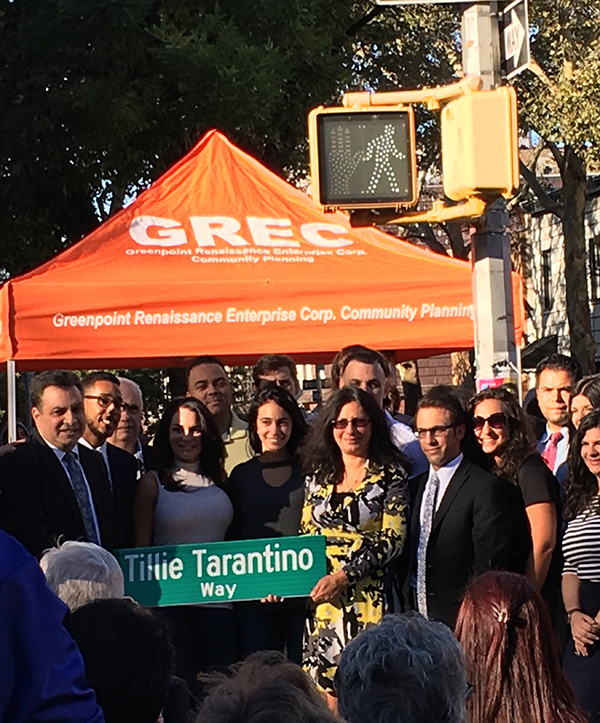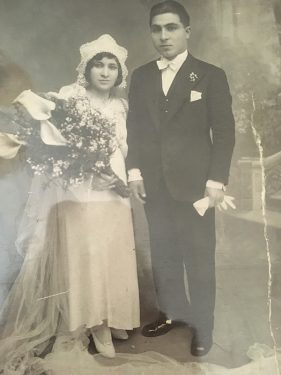
WINDSOR TERRACE — Whenever Angela Aragona walks out of her home on Conselyea Street in Williamsburg and looks up at the street sign on the corner, she can’t help but smile. After all, not everyone can say they live on a block named after their mother.
The sign, which reads “Tillie Tarantino Way,” was erected by New York City in 2017 as a tribute to Aragona’s late mother, a Williamsburg community activist who helped establish a senior citizens’ center in the neighborhood.
Tillie Tarantino Way is the most visible example of Aragona’s family ties to Williamsburg, which date back more than 100 years.
“My family has lived here since 1912,” said Aragona, a teacher at P.S. 132 located right in the neighborhood. Except for the few years she lived on Long Island after she got married, Aragona has lived in Williamsburg all her life.
The Conselyea Street house where Aragona lives is located next door to a house that her mother’s parents, Antonio and Amalia Manna, purchased 70 years ago, in the early 1950s. Manna was her mother Tillie Tarantino’s maiden name.
Aragona’s family enjoys ties to the Shrine Church of Our Lady of Mount Carmel that also date back to 1912. Today, Aragona is a eucharistic minister there, as are her two children, Joseph and Maria.
Monsignor Jamie Gigantiello, the pastor, said families like Aragona’s are important to the lifeblood of churches in the Diocese of Brooklyn.
“I think when a family has history, the family knows the traditions of the parish and the faith,” he said. “If the children and the grandchildren are all brought up with those traditions and faith experiences, there’s more likelihood that they would pass it on to the next generation. So it’s important as a way of passing on the faith.”
The annual Feast of Our Lady of Mount Carmel is also embedded into the family’s DNA. Five generations of men in the family have helped carry the 72-foot-tall, 4-ton Giglio through the streets. Aragon’s uncle, Phil Manna, was named Capo, or leader, of the feast in 2007. And in 2016, her son Joseph was the feast’s Turk, a designation that carries with it the honor of riding the boat through the streets.
And the family has another fascinating tie to the feast — Aragona’s grandparents hailed from Nola, Italy, the birthplace of the Giglio tradition.
The family’s story in Williamsburg begins in 1912 when Aragona’s maternal great-grandfather, Pasquale Vaniomen, moved into the neighborhood with his wife Carmela and their two daughters Caroline and Amalia. Years later, Amalia returned to Italy, where the family was originally from, and met Antonio Manna. The two fell in love and married in 1930. They came to the U.S. together and settled in Williamsburg.
“Williamsburg had a lot of Italians back then and many of them came from Naples, where my grandparents were from,” Aragona explained.

Antonio was an ironworker and Amalia was a seamstress. Within a few years, they moved into a house on Leonard Street purchased by Amalia’s sister Caroline and her husband, Michael Manna. Antonio and Michael were brothers.
“My grandmother and her sister married two brothers,” Aragona said. Both Antonio’s and Michael’s families lived in the Leonard Street house. Michael and Caroline’s daughter Frances Cacae and her husband Antonio live there today. Antonio and Amalia eventually bought a house on Conselyea Street.
The family attended Mass at Our Lady of Mount Carmel on Sundays and returned home to cook big, multi-course dinners with pasta as the centerpiece.
As a child, Aragona loved listening to her grandmother tell stories about the old church. The current church at 275 North 8th St. stands a block away from the original, which was demolished in the 1940s to make way for the construction of the Brooklyn-Queens Expressway. “I remember growing up hearing my grandmother talk about how beautiful the original church was,” Aragona said.
Aragona noted that when she was growing up in Williamsburg, there were still traces of the small-town feel her grandparents enjoyed.
“When I was young, everyone knew each other. You had to make sure you didn’t get in trouble because your mother or father would know right away. Everybody was family,” she said. “People sat on their stoops and kept watch over us. I remember my grandmother always had people in her house in the winter. And then during the summer months, they had coffee outside and watched us play outside. I have so many fond memories of that time.”
Williamsburg has changed a lot over the decades, as neighborhoods in New York City do. In the 1910s and 1920s, it wasn’t the “hipster” neighborhood it is today.
Back then, it was largely an industrial community filled with factories and warehouses and populated mostly by immigrants from Europe, including Germans and Italians. Today, the area is more diverse and has large Jewish and Latino populations.
But Aragon said Conselyea Street still maintains that small town, neighborly feel.
“My block has pretty much stayed the same,” she said. “When new people move in, even if they’re not Italian, they get into our traditions, like the feast. We’re all like one big family.”
